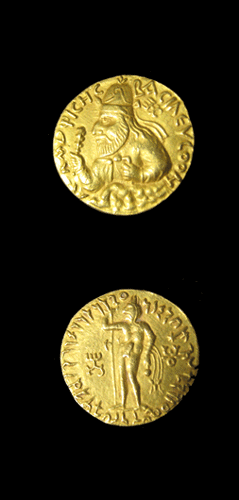Kushan Gold Dinar of Emperor Vima Kadphises, 100 CE - 128 CE
Gold
LC.136
Obverse: Bust of King Emerging from a Cloud with a Crested Helmet and Holding a Club. Reverse: Shiva with a Long Trident in Right Hand and the Skin of a...
Obverse: Bust of King Emerging from a Cloud with a Crested Helmet and Holding a Club.
Reverse: Shiva with a Long Trident in Right Hand and the Skin of a Tiger in the Left.
Vima Kadphises was the first great Kushan emperor, from around 90-100 CE. As detailed by the Rabatak inscription, he was the son of Vima Takto and the father of Kanishka. Vima Kadphises added to the Kushan territory by his conquests in Afghanistan and north-west India. He was the first to introduce gold coinage in India, in addition to the existing copper and silver coinage. Most of the gold seems to have been obtained through trade with the Roman Empire. The gold weight standard of approximately eight grams corresponds to that of the Roman coins of the 1st century. Gold bullion from Rome would be melted and used for the Kushan mints, into three denominations: the double stater, the stater, and the quarter starter (or dinara). The usage of gold testifies to the prosperity of the Kushan Empire from the time of Vima, being the center of trade between China, Central Asia and Alexandria and Antioch in the West. The Kushan were able to maintain and protect the Silk road, allowing silk, spices, textiles or medicine to move between China, India and the West. In particular, many goods were sent by ship to the Roman empire, creating a return flow of gold coins, Greek wine and slaves. Works of arts were also imported from all directions, as indicated by the variety and quality of the artefacts found in the Kushan summer capital of Bagram in Afghanistan. A strong artistic syncretism was stimulated, as indicated by the Greco-Buddhist art of Gandhara. Roman history relates the visit of ambassadors from the Indian kings to the court of Trajan (98-117 CE), bearing presents and letters in Greek, which were sent either by Vima Kadphises or his son Kanishka. Most of Vima's coins feature representations of Shiva, with or without his bull, or with Nandipada representing Shiva's bull Nandi.
Reverse: Shiva with a Long Trident in Right Hand and the Skin of a Tiger in the Left.
Vima Kadphises was the first great Kushan emperor, from around 90-100 CE. As detailed by the Rabatak inscription, he was the son of Vima Takto and the father of Kanishka. Vima Kadphises added to the Kushan territory by his conquests in Afghanistan and north-west India. He was the first to introduce gold coinage in India, in addition to the existing copper and silver coinage. Most of the gold seems to have been obtained through trade with the Roman Empire. The gold weight standard of approximately eight grams corresponds to that of the Roman coins of the 1st century. Gold bullion from Rome would be melted and used for the Kushan mints, into three denominations: the double stater, the stater, and the quarter starter (or dinara). The usage of gold testifies to the prosperity of the Kushan Empire from the time of Vima, being the center of trade between China, Central Asia and Alexandria and Antioch in the West. The Kushan were able to maintain and protect the Silk road, allowing silk, spices, textiles or medicine to move between China, India and the West. In particular, many goods were sent by ship to the Roman empire, creating a return flow of gold coins, Greek wine and slaves. Works of arts were also imported from all directions, as indicated by the variety and quality of the artefacts found in the Kushan summer capital of Bagram in Afghanistan. A strong artistic syncretism was stimulated, as indicated by the Greco-Buddhist art of Gandhara. Roman history relates the visit of ambassadors from the Indian kings to the court of Trajan (98-117 CE), bearing presents and letters in Greek, which were sent either by Vima Kadphises or his son Kanishka. Most of Vima's coins feature representations of Shiva, with or without his bull, or with Nandipada representing Shiva's bull Nandi.



